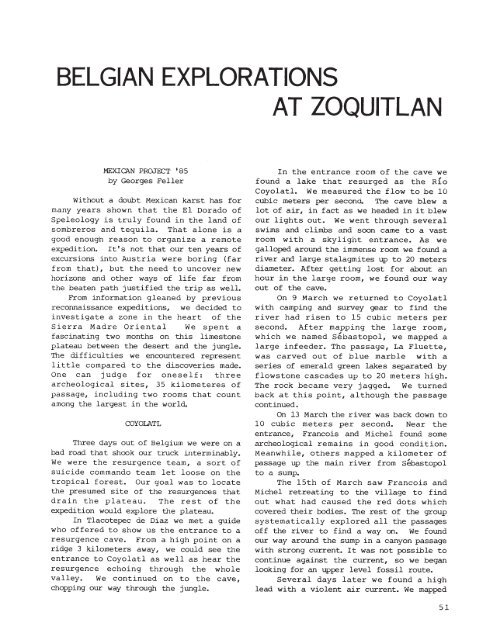8MB PDF - Association for Mexican Cave Studies
8MB PDF - Association for Mexican Cave Studies
8MB PDF - Association for Mexican Cave Studies
- No tags were found...
Create successful ePaper yourself
Turn your PDF publications into a flip-book with our unique Google optimized e-Paper software.
BELGIAN EXPLORATIONSAT ZOQUITLANMEXICAN PR~T '85by Georges FellerWithout a doubt <strong>Mexican</strong> karst has <strong>for</strong>many years shown that the El Dorado ofSpeleology is truly found in the land ofsombreros and tequila. That alone is agood enough reason to organize a remoteexpedition. It's not that our ten years ofexcursions into Austria were boring (farfrom that), but the need to uncover newhorizons and other ways of life far fromthe beaten path justified the trip as well.From in<strong>for</strong>mation gleaned by previousreconnaissance expeditions, we decided toinvestigate a zone in the heart of theSierra Madre Oriental We spent afascinating two months on this limestoneplateau between the desert and the jungle.The difficulties we encountered representlittle compared to the discoveries made.One can judge <strong>for</strong> oneself: threearcheological sites, 35 kilometeres ofpassage, including two rooms that countamong the largest in the world.COYOLATLThree days out of Belgium we were on abad road that shook our truck interminably.We were the resurgence team, a sort ofsuicide commando team let loose on thetropical <strong>for</strong>est. Our goal was to locatethe presumed site of the resurgences thatdrain the plateau. The rest of theexpedition would explore the plateau.In Tlacotepec de Diaz we met a guidewho offered to show us the entrance to aresurgence cave. From a high point on aridge 3 kilometers away, we could see theentrance to Coyolatl as well as hear theresurgence echoing through the Wholevalley. We continued on to the cave,chopping our way through the jungle.In the entrance room of the cave wefound a lake that resurged as the RIoCoyolatl. We measured the flow to be 10cubic meters per second. The cave blew alot of air, in fact as we headed in it blewour lights out. We went through severalswims and climbs and soon came to a vastroom with a skylight entrance. As wegalloped around the immense room we found ariver and large stalagmites up to 20 metersdiameter. After getting lost <strong>for</strong> about anhour in the large room, we found our wayout of the cave.On 9 March we returned to Coyolatlwith camping and survey gear to find theriver had risen to 15 cubic meters persecond. After mapping the large room,which we named Sebastopol, we mapped alarge infeeder. The passage, La Fluette,was carved out of blue marble with aseries of emerald green lakes separated byflowstone cascades up to 20 meters high.The rock became very jagged. We turnedback at this point, although the passagecontinued.On 13 March the river was back down to10 cubic meters per second. Near theentrance, Francois and Michel found somearcheological remains in good condition.Meanwhile, others mapped a kilometer ofpassage up the main river from Sebastopolto a sump.The 15th of March saw Francois andMichel retreating to the village to findout what had caused the red dots whichcovered their bodies. The rest of the groupsystematically explored all the passagesoff the river to find a way on. We foundour way around the sump in a canyon passagewith strong current. It was not possible tocontinue against the current, so we beganlooking <strong>for</strong> an upper level fossil route.Several days later we found a highlead with a violent air current. We mapped51
















